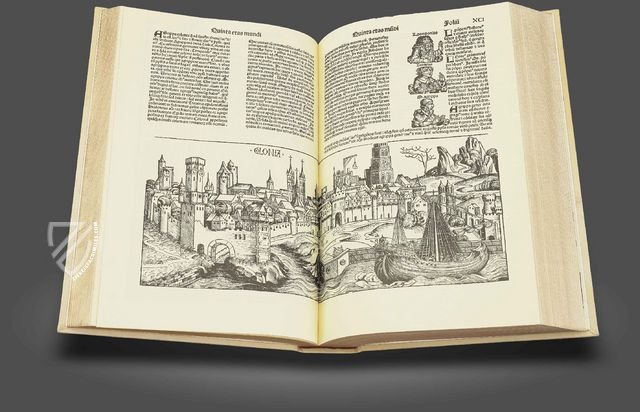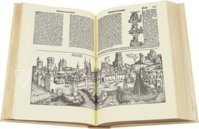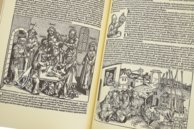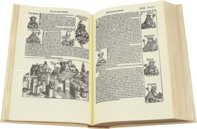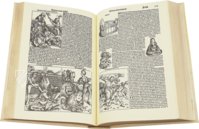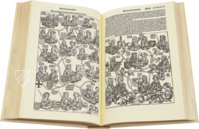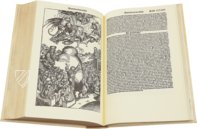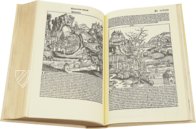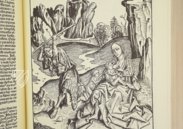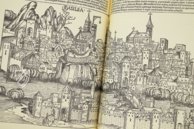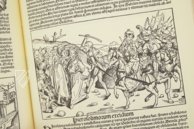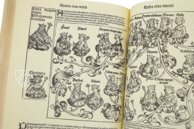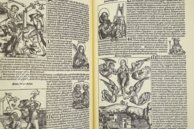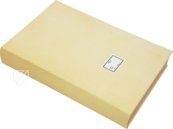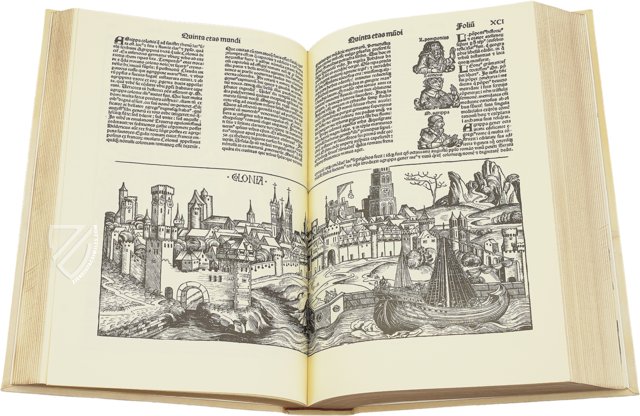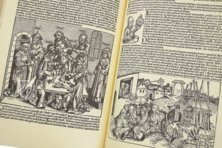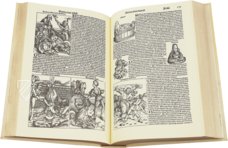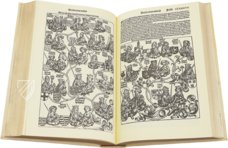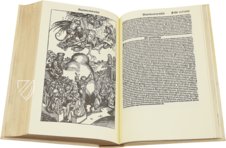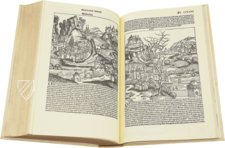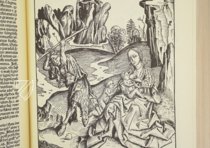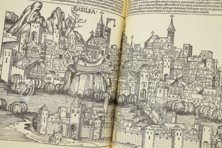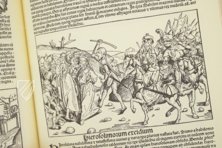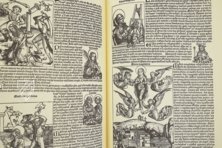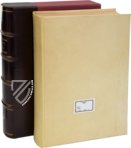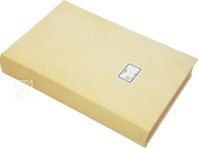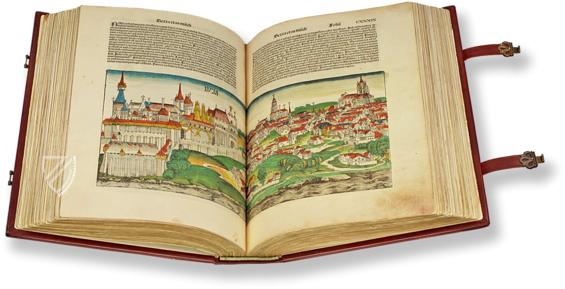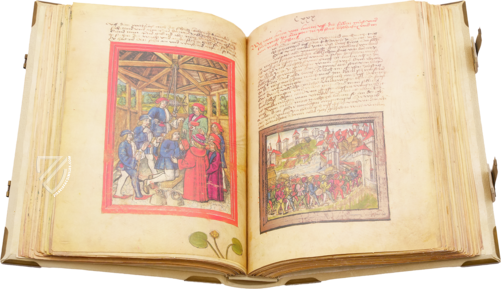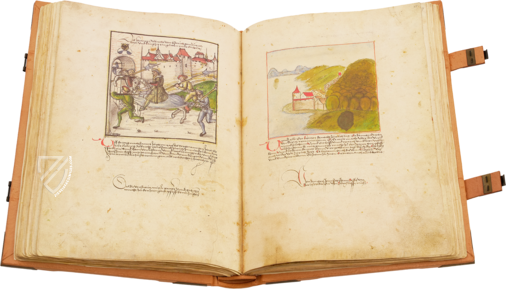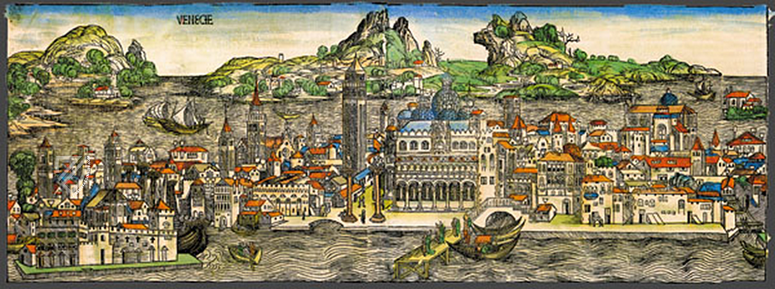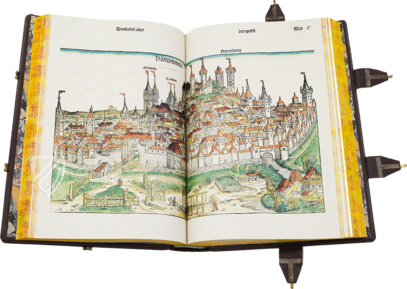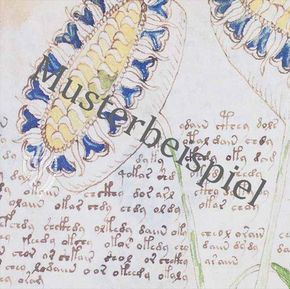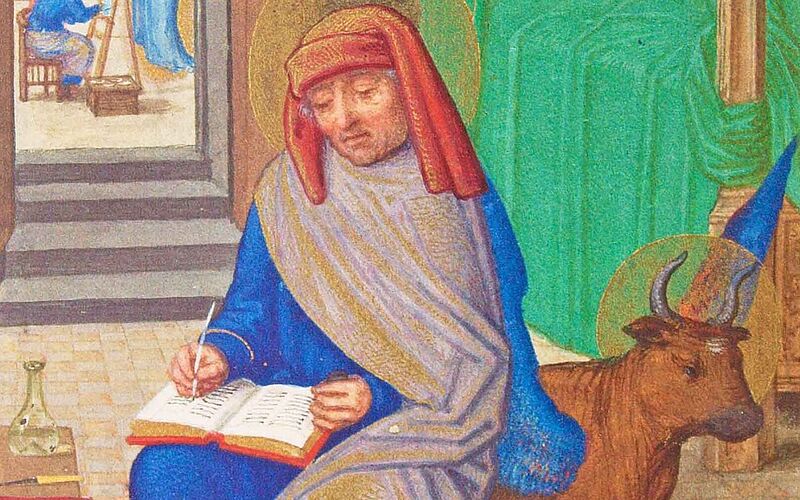Liber Chronicarum
(under 1,000€)
The Liber Chronicarum by Hartmann Schedel (1440–1514) boasts an impressive superlative: With a total of 1,821 engravings, the book is the most illustrated incunabulum in the world. The magnum opus by the Nuremberg physician, humanist and historian is also known as Schedel's World Chronicle and covers the history of the world from creation to the end of the 15th century. The aim was to depict the entire history known at the time, including all the important biblical, mythological and historical events and thus also the order of the world. Therefore, the astonishing incunabulum, printed by Anton Koberger in Nuremberg on July 12, 1493, was not only provided with 596 portraits of popes, emperors, kings and other important personalities, but also with hundreds of cityscapes and panoramas, 29 of them double-page. The two gifted masters Wilhelm Pleydenwurff (ca. 1420–72) and Michael Wolgemut (1434–1519) were responsible for this remarkable picture program. It is also likely that Albrecht Dürer (1471–1528), who was still an apprentice in Wolgemut's workshop at the time, contributed some woodcuts.
Liber Chronicarum
The Liber Chronicarum is considered to be the greatest and most significant book project from the early period of book printing. In the fascinating milieu of the Nuremberg humanists and artists of the late 15th century, a group gathered around Hartmann Schedel. The big names brought together: Michael Wolgemut – the teacher of Albrecht Dürer! – and Wilhelm Pleydenwurff as the artist of the grandiose woodcuts, Anton Koberger as the printer, with moneyed burghers and humanists as the patrons and financiers of the gigantic project. The significant Nuremberg Chronicle covers history from the creation of the world up to the year 1493 is particularly famous today for its wonderful cityscapes, of which some are considered to be the first realistic depiction of those cities.
A Renaissance Man Among Like-Minded People
Hartmann Schedel (1440–1514), a Nuremberg doctor, humanist, and historian followed the aim of giving a comprehensive, comprehensible ordering of the world with his chronicle. He succeeded in ingeniously implementing this intention. Nuremburg, the Franconian metropolis and South German center of humanism and art ca. 1500, offered the ideal conditions for it. Schedel, whose comprehensive library is still famous today, was esteemed in the highest circles of society in Nuremberg and consorted with all of the great minds of the city. As a result, he was successful in filling many of the burghers with excitement for the project and winning over the greatest names for it.
A History of the World
The chronicle spanning from the creation of the Earth up to the year 1493 is subdivided into six parts respective to the six ages of the world as was then typical. Thus, following the introduction by Isidore of Seville, Hermann Schedel appends it with a seventh and eighth part. In this attempt at an ordering of the world, the Renaissance man collected biblical stories, historical events and people, curious and sensational tales of wonder, and geographic information. As it was published in 1493, the Liber Chronicarum reflected the current state of knowledge at that time.
A Project without Precedent
The ambitious book project was transcribed in the famous printing shop of Anton Koberger (ca. 1400/45–1513). 100 typesetters and printers at 18 presses busied themselves with work on the world chronicle for fifteen months. On 568 pages, the work collects over 1,800 woodcuts, an unprecedented abundance of images. The responsibility for this artistic design rested with the exceptional artist Michael Wolgemut (1434–1519) together with Wilhelm Pleydenwurff (ca. 1420–72) and his workshop. This is even where the most famous Nuremberg artist of this time, Albrecht Dürer (1471–1528) did his apprenticeship until the year 1490. Whether he too participated in the book project is fiercely debated among researchers, but the fact that Koberger was his godfather is a strong indicator that he may have been.
The Fascinating Pictorial Adornment
The Liber Chronicarum contains numerous illustrations to stories from the Bible, lives of saints, miracle stories, and the like. Thus there is a page with a list and depiction of wondrous creatures from antique sources, similar to the miniatures of medieval bestiaries. Yet the illustrations of the geographical parts of the book are especially famous: 29 double-page cityscapes, a world map, and a map of Europe adorn the chronicle. Particularly outstanding is the woodcut of Nuremberg with the Kaiserburg, the Imperial Castle, which is enthroned above the city. However, Rome, Paris, Cologne, and countless other cities were also visually recorded and sometimes show the oldest realistic depictions of those cities. Schedel did not want any fantasy, but rather the most realistic views possible, which illustratively accompany the descriptions of the cities.
Famous Across Europe
The Liber Chronicarum was printed in two editions, one in Latin and a German edition, and was thus disseminated across Europe. Numerous specimens survive to today. The library of the Monastery of Santa Maria de la Vid in Spain houses a Latin specimen of this most important illustrated incunabulum. Schendel’s World Chronicle has gone down in history as the most ambitious book project of the incunabula period. A groundbreaking work, considered to be an important attestation of the connection between art and humanism in Nuremberg, the South German metropolis of the Middle Ages, and a superlative as a book project!
Codicology
- Alternative Titles
- Schedel's World Chronicle -- Nuremberg chronicle
- Size / Format
- 700 pages / 44.0 × 29.0 cm
- Origin
- Germany
- Date
- July 12th, 1492
- Epochs
- Style
- Language
- Illustrations
- 1821 engravings
- Artist / School
- Hartmann Schedel (author)
Albrecht Dürer (engraver)
Anton Koberger (printer)
Liber Chronicarum
Seneca the Younger
Renaissance Europe was obsessed with Roman history, particularly stories of those whose lives, and sometimes deaths, were defined by morality and honor. The Roman Stoic philosopher, statesman, and dramatist Seneca the Younger is one such figure. In AD 65, Seneca was wrongly accused of being involved in a plot to kill Emperor Nero and was ordered to commit suicide. He climbed into a hot bath and opened his veins in traditional fashion, but more importantly, did so with courage and selflessness.
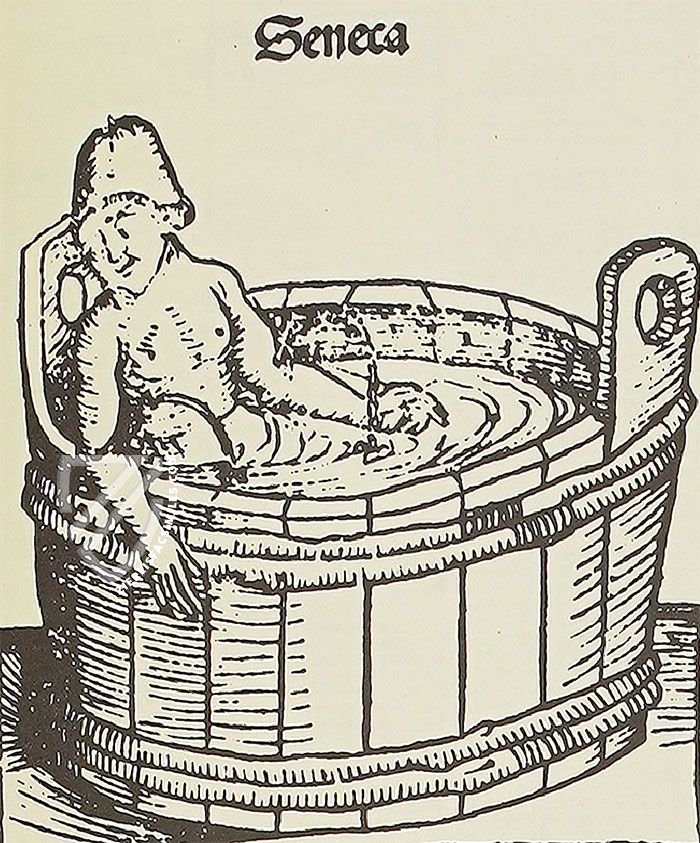
Liber Chronicarum
The Antichrist
According to Christian eschatology, the Antichrist is a figure or figures prophesied to present themselves as a substitute for Christ before the Second Coming. He is presented on the left as a preacher with the Devil whispering in his ear while Elijah and Enoch preach the true faith on the right; the Mount of Olives lies in between them and divides the wicked from the righteous.
After having climbed the Mount of Olives, the Antichrist is denied entry to Heaven and is struck down by the Archangel Michael before being dragged down to Hell by three demons, two of whom beat him with clubs. While most of the people in the two crowds take no notice, one figure stands and looks up with his hands extended above his head in a gesture of awe.
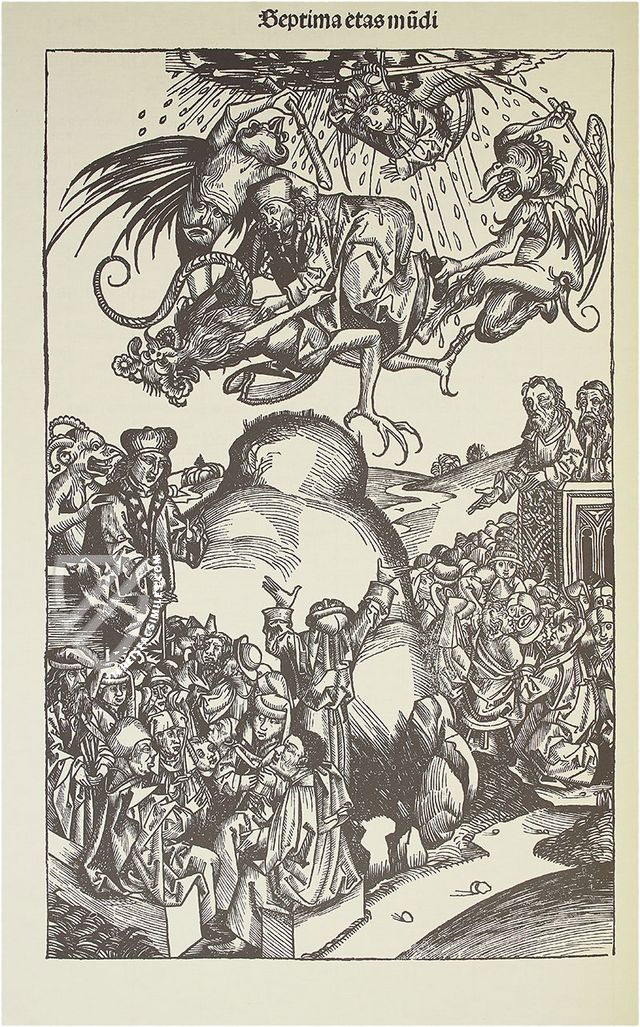
#1 Liber Chronicarum
(under 1,000€)
- Treatises / Secular Books
- Apocalypses / Beatus
- Astronomy / Astrology
- Bestiaries
- Bibles / Gospels
- Chronicles / History / Law
- Geography / Maps
- Saints' Lives
- Islam / Oriental
- Judaism / Hebrew
- Single Leaf Collections
- Leonardo da Vinci
- Literature / Poetry
- Liturgical Manuscripts
- Medicine / Botany / Alchemy
- Music
- Mythology / Prophecies
- Psalters
- Other Religious Books
- Games / Hunting
- Private Devotion Books
- Other Genres
- Afghanistan
- Armenia
- Austria
- Belgium
- Belize
- Bosnia and Herzegovina
- China
- Colombia
- Costa Rica
- Croatia
- Cyprus
- Czech Republic
- Denmark
- Egypt
- El Salvador
- Ethiopia
- France
- Germany
- Greece
- Guatemala
- Honduras
- Hungary
- India
- Iran
- Iraq
- Israel
- Italy
- Japan
- Jordan
- Kazakhstan
- Kyrgyzstan
- Lebanon
- Liechtenstein
- Luxembourg
- Mexico
- Morocco
- Netherlands
- Palestine
- Panama
- Peru
- Poland
- Portugal
- Romania
- Russia
- Serbia
- Spain
- Sri Lanka
- Sweden
- Switzerland
- Syria
- Tajikistan
- Turkey
- Turkmenistan
- Ukraine
- United Kingdom
- United States
- Uzbekistan
- Vatican City
- A. Oosthoek, van Holkema & Warendorf
- Aboca Museum
- Ajuntament de Valencia
- Akademie Verlag
- Akademische Druck- u. Verlagsanstalt (ADEVA)
- Aldo Ausilio Editore - Bottega d’Erasmo
- Alecto Historical Editions
- Alkuin Verlag
- Almqvist & Wiksell
- Amilcare Pizzi
- Andreas & Andreas Verlagsbuchhandlung
- Archa 90
- Archiv Verlag
- Archivi Edizioni
- Arnold Verlag
- ARS
- Ars Magna
- ArtCodex
- AyN Ediciones
- Azimuth Editions
- Badenia Verlag
- Bärenreiter-Verlag
- Belser Verlag
- Belser Verlag / WK Wertkontor
- Benziger Verlag
- Bernardinum Wydawnictwo
- BiblioGemma
- Biblioteca Apostolica Vaticana (Vaticanstadt, Vaticanstadt)
- Bibliotheca Palatina Faksimile Verlag
- Bibliotheca Rara
- Boydell & Brewer
- Bramante Edizioni
- Bredius Genootschap
- Brepols Publishers
- British Library
- C. Weckesser
- Caixa Catalunya
- Canesi
- CAPSA, Ars Scriptoria
- Caratzas Brothers, Publishers
- Carus Verlag
- Casamassima Libri
- Centrum Cartographie Verlag GmbH
- Chavane Verlag
- Christian Brandstätter Verlag
- Circulo Cientifico
- Club Bibliófilo Versol
- Club du Livre
- CM Editores
- Collegium Graphicum
- Collezione Apocrifa Da Vinci
- Comissão Nacional para as Comemorações dos Descobrimentos Portugueses
- Coron Verlag
- Corvina
- CTHS
- D. S. Brewer
- Damon
- De Agostini/UTET
- De Nederlandsche Boekhandel
- De Schutter
- Deuschle & Stemmle
- Deutscher Verlag für Kunstwissenschaft
- DIAMM
- Droz
- E. Schreiber Graphische Kunstanstalten
- Ediciones Boreal
- Ediciones Grial
- Ediclube
- Edições Inapa
- Edilan
- Editalia
- Edition Deuschle
- Edition Georg Popp
- Edition Leipzig
- Edition Libri Illustri
- Editiones Reales Sitios S. L.
- Éditions de l'Oiseau Lyre
- Editions Medicina Rara
- Editorial Casariego
- Editorial Mintzoa
- Editrice Antenore
- Editrice Velar
- Edizioni Edison
- Egeria, S.L.
- Eikon Editores
- Electa
- Emery Walker Limited
- Enciclopèdia Catalana
- Eos-Verlag
- Ephesus Publishing
- Ernst Battenberg
- Eugrammia Press
- Extraordinary Editions
- Fackelverlag
- Facsimila Art & Edition
- Facsimile Editions Ltd.
- Facsimilia Art & Edition Ebert KG
- Faksimile Verlag
- Feuermann Verlag
- Folger Shakespeare Library
- Franco Cosimo Panini Editore
- Friedrich Wittig Verlag
- Fundación Hullera Vasco-Leonesa
- G. Braziller
- Gabriele Mazzotta Editore
- Gebr. Mann Verlag
- Gesellschaft für graphische Industrie
- Getty Research Institute
- Giovanni Domenico de Rossi
- Giunti Editore
- Graffiti
- Grafica European Center of Fine Arts
- Guido Pressler
- Guillermo Blazquez
- Gustav Kiepenheuer
- H. N. Abrams
- Harrassowitz
- Harvard University Press
- Helikon
- Hendrickson Publishers
- Henning Oppermann
- Herder Verlag
- Hes & De Graaf Publishers
- Hoepli
- Holbein-Verlag
- Houghton Library
- Hugo Schmidt Verlag
- Idion Verlag
- Il Bulino, edizioni d'arte
- ILte
- Imago
- Insel Verlag
- Insel-Verlag Anton Kippenberger
- Instituto de Estudios Altoaragoneses
- Instituto Nacional de Antropología e Historia
- Istituto dell'Enciclopedia Italiana - Treccani
- Istituto Ellenico di Studi Bizantini e Postbizantini
- Istituto Geografico De Agostini
- Istituto Poligrafico e Zecca dello Stato
- Italarte Art Establishments
- Jan Thorbecke Verlag
- Johnson Reprint Corporation
- Josef Stocker
- Josef Stocker-Schmid
- Jugoslavija
- Karl W. Hiersemann
- Kasper Straube
- Kaydeda Ediciones
- Kindler Verlag / Coron Verlag
- Kodansha International Ltd.
- Konrad Kölbl Verlag
- Kurt Wolff Verlag
- La Liberia dello Stato
- La Linea Editrice
- La Meta Editore
- Lambert Schneider
- Landeskreditbank Baden-Württemberg
- Leo S. Olschki
- Les Incunables
- Liber Artis
- Library of Congress
- Libreria Musicale Italiana
- Lichtdruck
- Lito Immagine Editore
- Lumen Artis
- Lund Humphries
- M. Moleiro Editor
- Maison des Sciences de l'homme et de la société de Poitiers
- Manuscriptum
- Martinus Nijhoff
- Maruzen-Yushodo Co. Ltd.
- MASA
- Massada Publishers
- McGraw-Hill
- Metropolitan Museum of Art
- Militos
- Millennium Liber
- Müller & Schindler
- Nahar - Stavit
- Nahar and Steimatzky
- National Library of Wales
- Neri Pozza
- Nova Charta
- Oceanum Verlag
- Odeon
- Orbis Mediaevalis
- Orbis Pictus
- Österreichische Staatsdruckerei
- Oxford University Press
- Pageant Books
- Parzellers Buchverlag
- Patrimonio Ediciones
- Pattloch Verlag
- PIAF
- Pieper Verlag
- Plon-Nourrit et cie
- Poligrafiche Bolis
- Presses Universitaires de Strasbourg
- Prestel Verlag
- Princeton University Press
- Prisma Verlag
- Priuli & Verlucca, editori
- Pro Sport Verlag
- Propyläen Verlag
- Pytheas Books
- Quaternio Verlag Luzern
- Reales Sitios
- Recht-Verlag
- Reichert Verlag
- Reichsdruckerei
- Reprint Verlag
- Riehn & Reusch
- Roberto Vattori Editore
- Rosenkilde and Bagger
- Roxburghe Club
- Salerno Editrice
- Saltellus Press
- Sandoz
- Sarajevo Svjetlost
- Schöck ArtPrint Kft.
- Schulsinger Brothers
- Scolar Press
- Scrinium
- Scripta Maneant
- Scriptorium
- Shazar
- Siloé, arte y bibliofilia
- SISMEL - Edizioni del Galluzzo
- Sociedad Mexicana de Antropología
- Société des Bibliophiles & Iconophiles de Belgique
- Soncin Publishing
- Sorli Ediciones
- Stainer and Bell
- Studer
- Styria Verlag
- Sumptibus Pragopress
- Szegedi Tudomànyegyetem
- Taberna Libraria
- Tarshish Books
- Taschen
- Tempus Libri
- Testimonio Compañía Editorial
- Thames and Hudson
- The Clear Vue Publishing Partnership Limited
- The Facsimile Codex
- The Folio Society
- The Marquess of Normanby
- The Richard III and Yorkist History Trust
- Tip.Le.Co
- TouchArt
- TREC Publishing House
- TRI Publishing Co.
- Trident Editore
- Tuliba Collection
- Typis Regiae Officinae Polygraphicae
- Union Verlag Berlin
- Universidad de Granada
- University of California Press
- University of Chicago Press
- Urs Graf
- Vallecchi
- Van Wijnen
- VCH, Acta Humaniora
- VDI Verlag
- VEB Deutscher Verlag für Musik
- Verlag Anton Pustet / Andreas Verlag
- Verlag Bibliophile Drucke Josef Stocker
- Verlag der Münchner Drucke
- Verlag für Regionalgeschichte
- Verlag Styria
- Vicent Garcia Editores
- W. Turnowski Ltd.
- W. Turnowsky
- Waanders Printers
- Wiener Mechitharisten-Congregation (Wien, Österreich)
- Wissenschaftliche Buchgesellschaft
- Wissenschaftliche Verlagsgesellschaft
- Wydawnictwo Dolnoslaskie
- Xuntanza Editorial
- Zakład Narodowy
- Zollikofer AG

